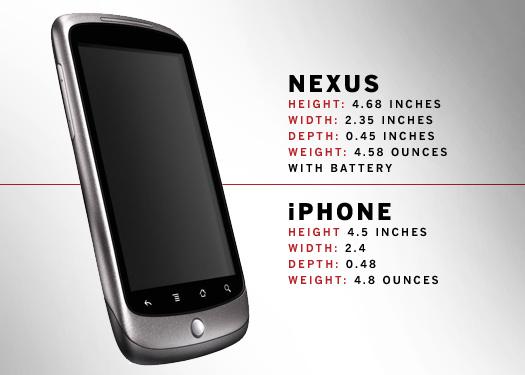-
Under the covers, part 1: processing power. Nexus One runs the Android 2.1 operating system on the Qualcomm QSD8250 Snapdragon chip [shown at right in this picture], a powerful yet low-powered 1GHz mobile CPU (also in HTC's HD2 and Toshiba TG01 smartphones). It's based on the same ARM Cortex-A8 core as the iPhone 3GS's Samsung S5PC100 chip, at 600 MHz. Photo Credit: iFixit
-
Under the covers, part 2: Memory, storage. Nexus One has 512MB FLASH and 512MB of RAM onboard, to support lots of multi-tasking apps, and impressing many reviewers with its speed. iPhone 3GS has 256MB RAM. A removable SD card gives Nexus One 4GB of storage (expandable to 32GB). But according to Walter Mossberg, Google only allows 190MB of all that to store apps. By contrast, nearly all of the 16G and 32GB on the iPhone flash drives is user-accessible.
-
Power and battery life. Nexus One has a removable 1400 mAH battery and claims up to 7 hours talktime and 250 hours standby time on a 3G network, and 6.5 hours of Internet use over Wi-Fi. iPhone 3GS with the built-in battery: 5 hours talktime, 300 hours standby on 3G; 9 hours of Wi-Fi Internet use (and users have complained that the 3GS battery life is worse than older models). TechCrunch: "all this [Nexus One] hardware bling is an energy hog." Shown: a lemon battery. Photo credit: Hila Science Center, Pembroke Ontario, Canada
-
Display. Nexus screen is 3.7-inches diagonal, 3.5 inches for iPhone, but has a much higher resolution: 800 x 480 pixels vs. 480x320 pixels. But Engadget says the Nexus' active-matrix organic light-emitting diode technology makes viewing the screen in daylight a "nightmare." And don't expect the slick multi-touch of the iPhone: Nexus is single-touch/gesture only. Gizmodo: "- N1's onscreen keyboard felt fine, and the speedy processor made sure that each key was interpreted well."
-
Operating system. Nexus One features release 2.1 of the Android operating system, with many of the changes focused on the user interface, including: easier homescreen navigation, expanded to five from three the number of homescreens with a "breadcrumb" line of corresponding white dots to cue you visually, greatly expanded voice control over phone features with every text field now voice-enabled for input. Nexus One supports multi-tasking which the iPhone still restricts to Apple applications. The iPhone 3.0 firmware release last year was well-received. Shown: Nexus voice-enabled gmail creation.
-
Wireless carrier. Nexus One is available first on T-Mobile's 3G network (a CDMA version is scheduled for this spring on Verizon Wireless). The most recent J. D. Power and Associates' survey puts T-Mobile in the lower ranks of U.S. carriers in terms of call quality (problems per 100 calls) in most regions. Yet a year ago, a separate Powers' survey ranked T-Mobile tops in customer care, followed by Verizon. AT&T is subjected to chronic complaints about network performance by many iPhone users.
-
The look and feel. Reviewers like the Nexus One's design – solid but silky, sleek and light.
-
Google's Nexus One, built by China's HTC, offers much of what one expects in a high-end 3G smartphone. Yet is it enough, and good enough, to give the iPhone 3GS a run for the money? Initial reviews like its design, speed and integration with the Web. With a two-year T-Mobile contract (at $80 per month), Nexus costs $179 (or $530 unlocked). A CDMA version is due with Verizon Wireless in Spring 2010. In this slideshow, we focus on some of the key differences, comparing the two smartphones in terms of their published specifications, with some comments from (and links to) early reviews and assessments of the Nexus.
-
Web browser. Both Google's Android browser and Apple's Safari are based on the open-source Webkit engine. The Android browser is already No. 2 in U.S. smartphone Web traffic. Adobe has a YouTube demo of the Android browser running Flash Player 10.1 (currently in beta), on the Nexus One. Shown: Nexus One Android browser with Flash Player 10.1 Photo credit: Adobe via Android Community
-
Networking. Nexus One is a GSM phone, initially available in the U.S. on T-Mobile's High Speed Packet Access (HSPA) 3G network, with up to 7.2Mbps uplinks. The cellular RF transceiver is the Qualcomm RTR6285 chip which supports multiple UMTS bands and quad-band GSM/EDGE, with integrated GPS. Google promises a CDMA version will be available for Verizon Wireless. In the U.S., iPhone 3GS runs only on AT&T's 3G and EDGE networks. Wi-Fi and Bluetooth (and FM radio) are integrated on a single Broadcom chip, the BCM4329 http://www.broadcom.com/products/Bluetooth/Bluetooth-RF-Silicon-and-Software-Solutions/BCM4329, the same chip in iPhone 3GS. The difference: in the Nexus One, support for high-throughput 802.11n is turned on, but not in the iPhone. Photo credit: iFixit
-
Applications. Nexus One users can choose from a rapidly growing body of applications for Android, about 18,000 according to Walter Mossberg. The iPhone clearly has a huge advantage here: well over 100,000 third-party apps available via the pioneering online App Store. But Google is pushing hard to tightly and smoothly integrate users and their data with Web services. Shown: Part of the universe of iPhone apps.
Google Nexus One vs Apple iPhone 3GS
11 Photos
Smartphone showdown: How Google's offering compares to Apple's high-end iPhone











